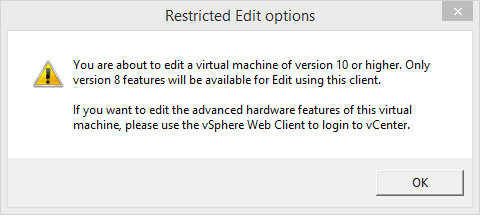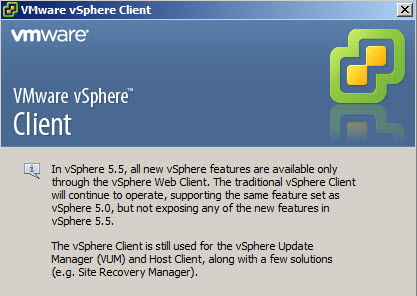

- #Vmware vsphere 5.5 client install#
- #Vmware vsphere 5.5 client software#
- #Vmware vsphere 5.5 client trial#
- #Vmware vsphere 5.5 client password#
To the IP address of your vCenter server.Ī data center and a cluster, and then add all your physical hosts. VCenter is installed, you can close your client, re-open it, and connect
#Vmware vsphere 5.5 client install#
(SSO, Inventory Service, and vCenter) to install everything you need for Windows is installed, attach the vCenter ISO to the VM and do the Simple Install The Windows Server ISO to the VM and power it on.
Create domain admins to use for your vCenter. After Windows is installed, do a DCPROMO to. Attach the Windows Server ISO to the VM and. Create a new VM for your domain controller by. Now you're in the vSphere Client, which is where you'll do most of your 
#Vmware vsphere 5.5 client password#
Your ESXi server, along with username (root) and the password you specifiedĭuring the ESXi install.
In the vSphere Client, enter the IP address of. Click the link and open the vSphere Client. On your remote computer, open a browser and browse to the IP address you gaveĭownload the vSphere Client. Repeat these steps for each physical server.Ĭonnect to your ESXi server from a remote computer. Once you have it configured, try to ping the new. The server with things like IP addresses, gateways, and host names. Once it's installed, press F2 to configure. Specify which drive you want to install ESXi on and click F11 and Enter a lot. Load the CD and start the server (make sure. Create a boot disk with the ESXi image (.ISO). Windows Server 2008 R2 and Windows Server 2012: Although this isn't absolutely necessary, you'll need this for vCenter as notedĪbove, and you'll probably want to create a domain controller so you can test. Version first then, after you gain some experience, you can try to deploy the Virtual Appliance. Installer to put on a Windows 2008 R2 or Windows 2012 server. vCenterĬan be a Virtual Appliance that you download and deploy, or you can download an That gives you all the cool features you hear about, including HA, DRS, vMotion, and dozens more. #Vmware vsphere 5.5 client software#
vCenter 5.5: This is the management software. 
You load on to each of your physical hosts (or servers). ESXi 5.5: ESXi is the VMware operating system.Need to create a new login (it's free when you supply your email address).
#Vmware vsphere 5.5 client trial#
To download the trial versions of these components, you'll Most recently released version, though the basics apply to all the versions. You'll need to download trial versions of vSphere components. The switch, you can start installing the software. Storage, and potentially the laptop or desktop you plan to use to connect. Possible to use the vSphere Storage Appliance (VSA) with your local drives on the physical hosts, though this is a more advanced This isn't necessary for a vSphere install, but you'll need it if you want to
A storage device (e.g., Iomega StorCenter) that you can connect to your servers. Also, you need to make sure the servers offer virtualization support, which often can be enabled in the BIOS. These servers need at least 4 GB of RAMĮach, but more RAM is always better. One server, though two servers are preferable so you can work with cluster features such as Distributed Resource Scheduler (DRS) and High Availability (HA). Not to suggest the best hardware, because you'll most likely be using old servers or desktops that you already have.) Hardware My first piece ofĪdvice is to create a home or practice lab. This high-level overview outlines what you need to get a VMware vSphere 5.5 home lab up and running there's a lot of documentation out there to help you with the actual installs. I've received a couple of emails from readers asking how virtualization beginners can gain experience.







 0 kommentar(er)
0 kommentar(er)
